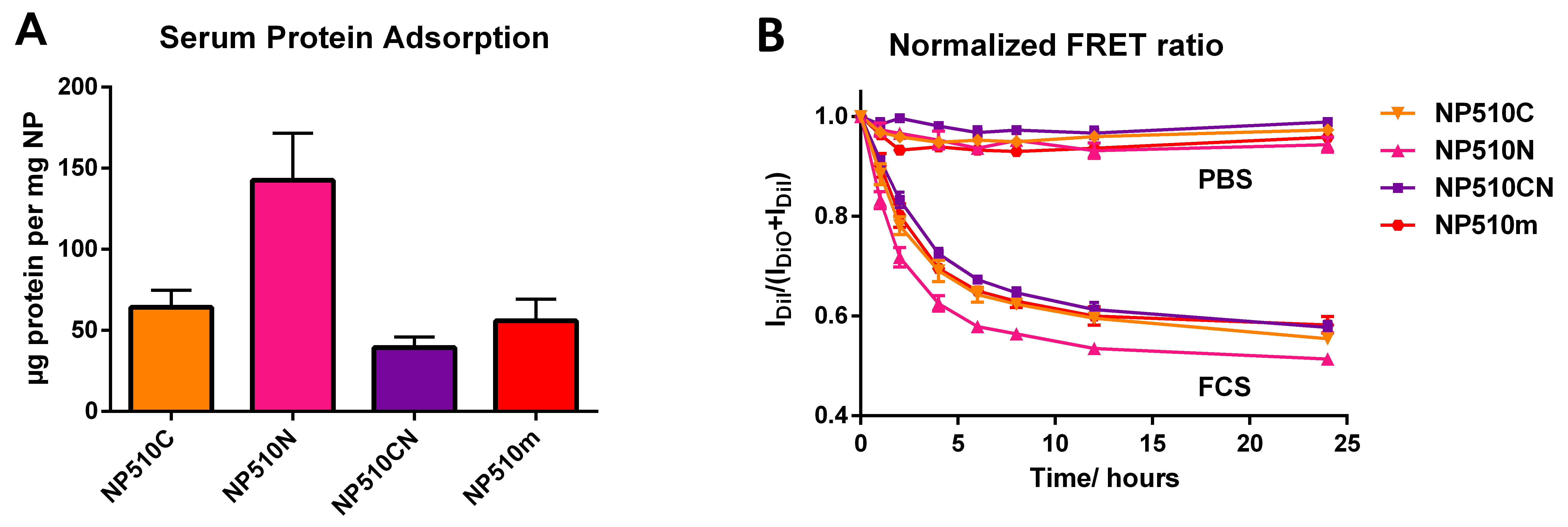Introduction: Formation of a nanoparticle (NP) protein corona upon administration into the bloodstream plays a pivotal role concerning safety and efficacy of nanoparticle formulations. As a result of the complex interplay between chemical and physical factors, it is particularly challenging to forecast the extent and composition of protein adsorption onto different nanomaterials. Therefore, the aim of this study was to characterize the interaction of serum proteins with poly(lactic-co-glycolic acid) blended poly(ethylene glycol)-polylactid acid (PEG-PLA/PLGA) NPs depending on particle charge and net charge density. Moreover, impact on NP stability and cell toxicity in vitro was assessed. For this purpose methoxy- (m), carboxy- (C) and amino-functionalized (N) PEG-PLA copolymers were used to prepare NPs with a negative (NP510C), positive (NP510N) or uncharged (NP510m) surface as well as dual charged particles (NP510CN).
Materials and Methods: PEG-PLA copolymers were synthesized by ring-opening polymerization and NPs were prepared by nanoprecipitation as previously described [1]. Size and zeta potential was measured on a Zetasizer Nano ZS. Serum protein adsorption was evaluated by incubation of functionalized nanoparticles with fetal calf serum (FCS) at 37 °C. Composition of the hard protein corona was analyzed by sodium dodecyl sulfate polyacrylamide gel electrophoresis (SDS-PAGE) and total protein amount was determined using Micro BCA Assay. The involvement of bovine serum albumin (BSA) in the soft and hard protein corona was assessed by DLS upon incubation with NP at 37 °C. NP stability was evaluated with a fluorescence resonance energy transfer (FRET) experiment as previously described [2]. Influence on cell toxicity was investigated by MTT assay.
Results and Discussion: NP surface charge has been shown to influence protein corona formation [3]. As depicted in Fig. 1 A, positively charged NP adsorbed significantly more serum proteins than negatively charged. Furthermore, interaction with serum proteins was even more decreased when particle surface was dual charged (NP510CN) compared to uncharged nanoparticles (NP510m). A FRET experiment revealed that NP stability in serum is directly correlated with the extent of protein adsorption. This may be due to the fact that formation of a protein corona has a strong impact on NP integrity. As a consequence thereof an escape of the lipophilic cargo was facilitated which led to a decrease of the FRET ratio over time [Fig. 1 B]. As interactions with serum proteins are likely to influence cell-NP interactions, cytotoxicity of NPs was assessed by MTT assay. It could be observed that cytotoxicity of NPs was significantly decreased when cell media was supplemented with FCS which indicates that unspecific cellular uptake was interfered by formation of a protein corona.

Figure 1: A) Quantification of the hard protein corona of different NP formulations determined by BCA assay B) FRET stability of NP formulations in PBS pH 7.4 and FCS as a function of time
Conclusion: The electrostatic interaction of polymeric NP with serum proteins can be regulated by combining differently functionalized PEG-PLA copolymers. Such tailored NPs can be used to control the extent of protein adsorption onto NP surface and thus NP stability and toxicity in vitro.
References:
[1] F. Brandl, N. Bertrand, E.M. Lima, R. Langer, Nanoparticles with photoinduced precipitation for the extraction of pollutants from water and soil, Nat. Commun. 6, 7765 (2015). doi:10.1038/ncomms8765
[2] J. Lu, S. C. Owen, M.S. Shoichet, Stability of Self-Assembled Polymeric Micelles in Serum, Macromolecules. 44, 6002–6008 (2011). doi:10.1021/ma200675w
[3] M. Lundquist, J. Stigler, G. Elia, I. Lynch, T. Cedervall, K.A. Dawson, Nanoparticle size and surface properties determine the protein corona with possible implications for biological impacts, Proc Natl Acad Sci USA. 105, 14265.14270 (2008). doi: 10.1073/pnas.0805135105